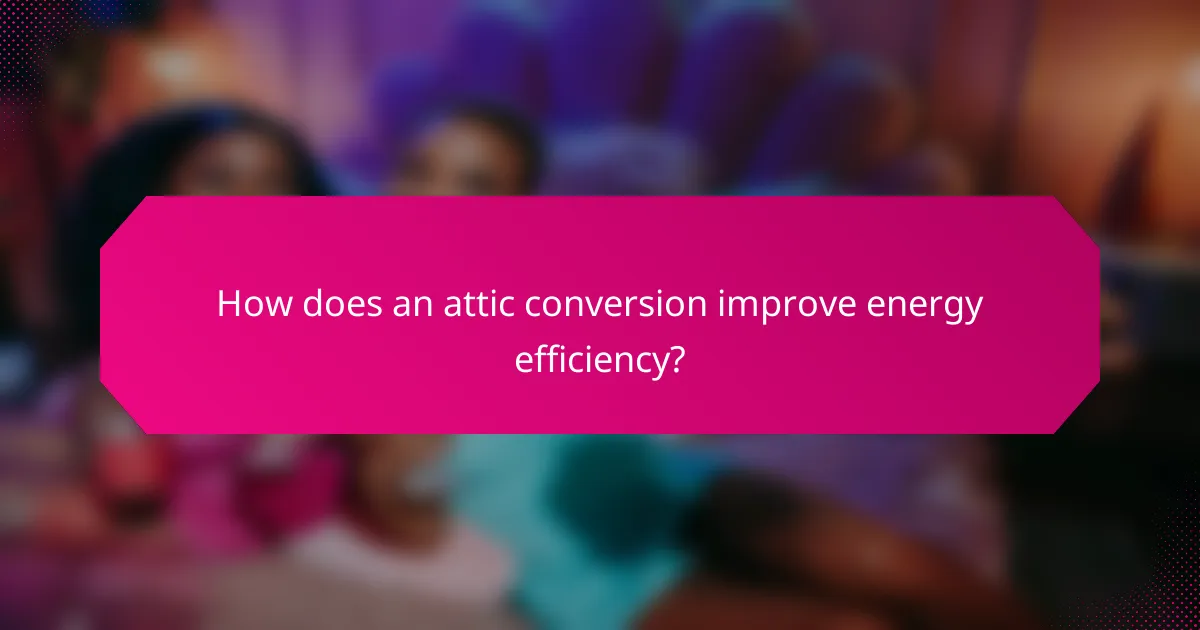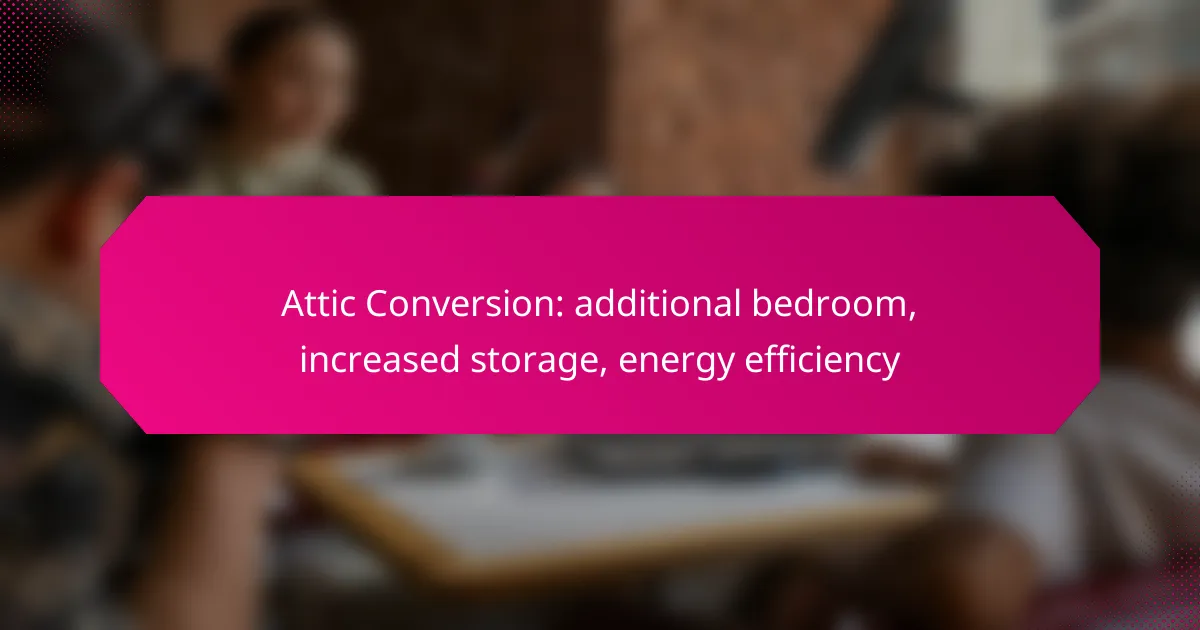An attic conversion is a smart way to transform unused space into an additional bedroom, increasing both the functionality and value of your home. This process not only maximizes storage capacity with tailored solutions but also enhances energy efficiency through improved insulation and air circulation, leading to lower utility costs. By following local building regulations, homeowners can create a comfortable and aesthetically pleasing living area that meets their needs.

How can an attic conversion create an additional bedroom in London?
An attic conversion can effectively transform unused space into an additional bedroom in London, maximizing property value and utility. By adhering to local building regulations and design standards, homeowners can create a functional living area that enhances both comfort and aesthetics.
Maximizing space with dormer extensions
Dormer extensions are a popular choice for attic conversions, as they increase headroom and floor space. These structures can be added to the rear or front of the property, allowing for larger windows and improved natural light. In London, planning permission is often required for dormer extensions, so it’s essential to consult local regulations before proceeding.
Consider the design and placement of the dormer to ensure it complements the existing architecture. A well-placed dormer can significantly enhance the overall appearance of the home while providing the necessary space for a comfortable bedroom.
Designing functional layouts for bedrooms
When designing a bedroom in an attic conversion, focus on creating a functional layout that maximizes space and comfort. Utilize built-in storage solutions, such as under-eave cupboards, to keep the area organized and free from clutter. Aim for a layout that allows for easy movement and access to essential areas like windows and doors.
Incorporate sloped ceilings into the design by using low-profile furniture and strategically placing lighting fixtures. This approach can create a cozy atmosphere while making the most of the available space. Consider the placement of electrical outlets and heating sources to ensure the room is both practical and inviting.

What are the storage benefits of an attic conversion?
An attic conversion can significantly enhance storage capacity by transforming unused space into functional areas. This process not only maximizes the available square footage but also allows for creative storage solutions tailored to your needs.
Creating built-in storage solutions
Built-in storage solutions are an effective way to utilize the unique dimensions of an attic. Custom shelving, cabinets, and drawers can be designed to fit snugly under sloped ceilings, making the most of every inch. Consider using materials that blend with the existing decor to maintain a cohesive look.
Incorporating features like pull-out shelves or hidden compartments can enhance accessibility and organization. This approach can help keep the space tidy while providing ample storage for seasonal items, clothing, or other belongings.
Utilizing under-eave spaces effectively
Under-eave spaces often go unused in attics, but they can be transformed into valuable storage areas. Installing low-profile shelving or using decorative boxes can turn these awkward spaces into practical storage solutions. Consider labeling boxes for easy identification of contents.
Another option is to create a small closet or wardrobe in these areas, which can be particularly useful for storing clothing or linens. Just ensure that the design allows for ventilation to prevent moisture buildup, especially in regions with high humidity.

How does an attic conversion improve energy efficiency?
An attic conversion enhances energy efficiency by optimizing insulation, improving air circulation, and utilizing energy-efficient windows. These upgrades help maintain a consistent temperature, reduce heating and cooling costs, and minimize energy waste.
Insulation upgrades for temperature control
Upgrading insulation in an attic conversion is crucial for effective temperature control. High-quality insulation materials, such as spray foam or fiberglass batts, can significantly reduce heat loss in winter and keep the space cooler in summer. Aim for an R-value of at least 30 to 49, depending on your climate zone.
When selecting insulation, consider both the type and thickness. For instance, spray foam provides superior air sealing, while fiberglass is often more cost-effective. Ensure that the insulation is installed correctly to avoid gaps that could lead to energy inefficiency.
Energy-efficient windows and ventilation
Installing energy-efficient windows is essential for maximizing energy savings in an attic conversion. Look for windows with a low U-factor and high Solar Heat Gain Coefficient (SHGC) to minimize heat transfer. Double or triple glazing can further enhance insulation, reducing the need for heating and cooling.
Proper ventilation is equally important to maintain air quality and comfort. Consider incorporating roof vents, gable vents, or a ridge vent system to promote airflow. This helps prevent moisture buildup, which can lead to mold and structural issues, while also ensuring a comfortable living environment.

What are the costs associated with attic conversions in the UK?
The costs of attic conversions in the UK can vary widely, typically ranging from £20,000 to £50,000, depending on the complexity and specifications of the project. Factors such as the size of the attic, the type of conversion, and local labor rates significantly influence the overall expenses.
Average pricing for conversion projects
On average, a basic attic conversion can start around £20,000, while more complex projects, such as those requiring dormer extensions or extensive structural changes, can exceed £50,000. A typical conversion that adds a bedroom and storage may fall within the £30,000 to £40,000 range.
Additional costs may arise from necessary permits, design fees, and potential structural reinforcements. It’s advisable to obtain multiple quotes from contractors to ensure competitive pricing.
Factors influencing conversion costs
Several key factors can affect the costs of attic conversions, including the size of the space, the type of conversion (e.g., roof light, dormer, or mansard), and the quality of materials used. Larger spaces generally require more extensive work and materials, thus increasing costs.
Local labor rates and regulations can also play a significant role. In some areas, planning permissions may be required, which can add to the timeline and expenses. It’s crucial to factor in these elements when budgeting for an attic conversion project.

What regulations must be considered for attic conversions?
When planning an attic conversion, it’s essential to consider local regulations that govern such projects. These regulations typically include planning permission and building regulations, which ensure safety, structural integrity, and compliance with local zoning laws.
Planning permission requirements in England
In England, not all attic conversions require planning permission, especially if they fall under permitted development rights. However, if the conversion involves significant alterations to the roof structure or extends beyond the original building line, you will likely need to apply for planning permission.
To determine if your project requires permission, check with your local planning authority. They can provide guidance on specific requirements and any potential restrictions based on your property’s location and type.
Building regulations compliance
Building regulations are mandatory for attic conversions in England, regardless of whether planning permission is needed. These regulations cover various aspects, including structural safety, fire safety, insulation, and ventilation. Compliance ensures that the conversion is safe and habitable.
Key areas to focus on include ensuring adequate headroom, proper insulation to meet energy efficiency standards, and the installation of fire escapes if necessary. Engaging a qualified architect or builder familiar with local building codes can help navigate these requirements effectively.

How to choose the right contractor for an attic conversion?
Choosing the right contractor for an attic conversion involves assessing their qualifications, experience, and customer feedback. Look for professionals who specialize in attic renovations and have a strong track record of successful projects.
Evaluating contractor experience and reviews
Start by checking the contractor’s experience specifically in attic conversions. Look for at least five years in the industry and a portfolio showcasing similar projects. Online reviews and testimonials can provide insights into their reliability and quality of work.
Consider asking for references from previous clients to gauge satisfaction levels. A contractor with positive feedback and a good reputation is more likely to deliver a successful conversion.
Comparing quotes and services
When comparing quotes, ensure you are evaluating similar services. A detailed breakdown of costs, including labor, materials, and any additional fees, will help you make an informed decision. Quotes can vary widely, so aim for a range that reflects the average market rates in your area.
Don’t just focus on the lowest price; consider the value offered. Look for contractors who provide warranties or guarantees on their work, as this can indicate confidence in their services. Additionally, check if they are licensed and insured, which is crucial for protecting your investment.

What design trends are popular for attic conversions?
Popular design trends for attic conversions focus on maximizing space, enhancing natural light, and incorporating sustainable materials. Homeowners often seek to create functional areas that blend style with practicality, making the most of their available square footage.
Open-Plan Layouts
Open-plan layouts are increasingly favored in attic conversions as they create a sense of spaciousness. By removing unnecessary walls, homeowners can achieve a more fluid living area that accommodates various functions, such as a bedroom, office, or lounge. This design also allows for better airflow and natural light distribution.
Natural Light Maximization
Incorporating skylights and large windows is a key trend to enhance natural light in attic spaces. These features not only brighten the area but also create a more inviting atmosphere. Consider using energy-efficient glazing to improve insulation while allowing ample sunlight.
Sustainable Materials
Using sustainable materials is a growing trend in attic conversions, reflecting a commitment to environmental responsibility. Homeowners are opting for reclaimed wood, low-VOC paints, and energy-efficient insulation. These choices not only reduce the carbon footprint but can also lead to long-term savings on energy bills.
Multi-Functional Spaces
Designing multi-functional spaces is essential in attic conversions due to limited square footage. Consider incorporating built-in furniture, such as fold-out desks or Murphy beds, to maximize usability. This approach allows for a seamless transition between different activities, making the space more versatile.
Modern Aesthetics
Modern aesthetics, characterized by clean lines and minimalistic design, are popular in attic conversions. This style emphasizes simplicity and functionality, often featuring neutral color palettes and sleek furnishings. A modern approach can make the attic feel more open and less cluttered, enhancing its overall appeal.
